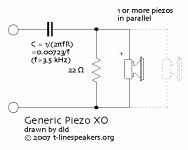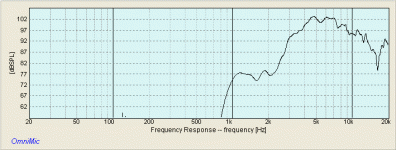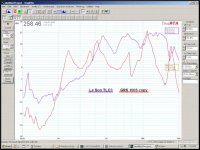Interesting thread but What an arrogant comment.Metal Oxide Varistor ??? Yikes! ...did we not have formal schooling on this, or did this "hobby" come to you thru osmosis, a passing interest or???
You do know a piezo element functions in a capacitive manner, right?
...
You think people need to be educated to enjoy a hobby?
I started this hobby before I learned English at the age of 9.
To be honest I’ve never heard about a MOV myself.
I knew my way around watts and crossovers before junior high but never once did I come across anything of this term in speakers and I did not see anything like it any crossover designs.
I’m also an electrical engineer and I cannot recall this term in any of the books either, it was all about AC/DC current voltage, caps coils resistors (filters), op-amps, active/reactive effect and efficiency, imaginary numbers and transfer functions, but not once did we enter the domain of piezos nor MOV. To me a MOV is a Motor Operated Valve lol.
I had to google it and yes I’ve seen such components inside amps. So I guess this is something you learn about in the subject of electronics which most people do not know about, it’s a rather obscure competence today. I’ve never seen a varistor in a passive crossover or in series with a piezo. I’ve seen resistors though. It was typically said back in the day that piezo only needed a 150 ohm series to protect the amp. If you need more power you would just serial number of piezo drivers. Have I missed something?
For protection of HF drivers one can use automobile bulb fuses, they compress the peaks and start to blink as you are playing loud indicating that you need to tone down. Typically 20 watt. Have no idea if they would work also on piezo. As piezos are several 100s or maybe 1000 ohm (is this right by the way?) I doubt it will.
I’ve never heard a speaker with piezo sounding good at high levels
Last edited:
The information in GM's post #8 is very comprehensive.
The same information is nicely presented here: Frugal-phile | Piezo Tweeter Crossovers | J Risch
The same information is nicely presented here: Frugal-phile | Piezo Tweeter Crossovers | J Risch
Last edited:
So it seems only parallel resistor is needed, not serial? Let’s say you want to cross at 8kHz would you only consider the parallel resistor then in the calculation ie number of piezo element is irrelevant electrically but adds to sensitivity and power handling through attenuation?
The calculation C = 0.00723f gives the required capacitor value provided the parallel R = 22 ohm and f > 3.5kHz.
According to the diagram in my link (see attachment), any number of parallel piezos can be used in conjunction with C and the parallel 22 ohm resistor, which will increase the power handling.
There is no need for a series resistor unless you want to tame the top end as described in the final paragraph of my link.
According to the diagram in my link (see attachment), any number of parallel piezos can be used in conjunction with C and the parallel 22 ohm resistor, which will increase the power handling.
There is no need for a series resistor unless you want to tame the top end as described in the final paragraph of my link.
Attachments
Last edited:
Interesting.
Have a bunch of piezo laying around gathering dust because I never liked the sound (I only used a serial resistor as indicated by some shops to protect the amp). Now I know better maybe it’s worth a try. I see a ton of interesting schemes in the PDF from post 8: 4 in serial/parallel with a bulb/PTC and a 5kHz cutoff using 1uF and 50 ohm serial and 22 ohm parallel would be interesting in a high power low cost party speaker.
Have a bunch of piezo laying around gathering dust because I never liked the sound (I only used a serial resistor as indicated by some shops to protect the amp). Now I know better maybe it’s worth a try. I see a ton of interesting schemes in the PDF from post 8: 4 in serial/parallel with a bulb/PTC and a 5kHz cutoff using 1uF and 50 ohm serial and 22 ohm parallel would be interesting in a high power low cost party speaker.
Last edited:
does that tame the 6+ dB bump found at resonance with a lot of 0.16uF piezo?
The series resistor is to ensure amplifier stability as Z is dropping low in the ultrasonic region.
look at the network effects diyAudio member Sonce provided with a KSN1016
(it is tuned for 1005 so does not work as well with KSN1016 - maybe a smaller input cap would fine tune? )


The series resistor is to ensure amplifier stability as Z is dropping low in the ultrasonic region.
look at the network effects diyAudio member Sonce provided with a KSN1016
(it is tuned for 1005 so does not work as well with KSN1016 - maybe a smaller input cap would fine tune? )


Last edited:
I'm still not doing it ....... unless I needed a super tweeter above (say) 6Khz and not for rock and roll.
Do I need a super tweeter?
Do I need a super tweeter?
Thanks, very useful.look at the network effects diyAudio member Sonce provided with a KSN1016
(it is tuned for 1005 so does not work as well with KSN1016 - maybe a smaller input cap would fine tune? )
I'm still not doing it ....... unless I needed a super tweeter above (say) 6Khz and not for rock and roll.
Do I need a super tweeter?
No. PSD2002 will outperform any piezo.
I'm wondering if there isn't a units issue here?
with: "C = 0.00723f" I'm seeing 72.3 (uF?) at 10,000 hz which seems crazy, and the lowpass frequency goes up with a larger capacitor. Help needed. Thanks
with: "C = 0.00723f" I'm seeing 72.3 (uF?) at 10,000 hz which seems crazy, and the lowpass frequency goes up with a larger capacitor. Help needed. Thanks
@ freddi
I bought a bunch of cheap piezo tweeters from PE years ago.
Tested them out and they are all very peaky, just like your GRS.
I bought a bunch of cheap piezo tweeters from PE years ago.
Tested them out and they are all very peaky, just like your GRS.
Aweful
Motorola 1038a was amazing.
I used it actively 24db LR at 5khz (fs peak at 4.5k).
I think freddyi had amazing luck with motorola 1016a.
Done right(good driver and active cross over or tranformer coupled with zobel / notch / and a bit of resistance piezo side in series for better loading of 60ohm side of transformer), they are amazing.
But i don't know if anyone makes a good one now.
Bigger ones 1142 (maybe) had 8khz resonance that could not be notched out.
Look up djk on audioasylum, high efficiency asylum actually.
Gold mine of information on how to use a piezo properly, which ones to buy, and how to use them.
Motorola 1038a was amazing.
I used it actively 24db LR at 5khz (fs peak at 4.5k).
I think freddyi had amazing luck with motorola 1016a.
Done right(good driver and active cross over or tranformer coupled with zobel / notch / and a bit of resistance piezo side in series for better loading of 60ohm side of transformer), they are amazing.
But i don't know if anyone makes a good one now.
Bigger ones 1142 (maybe) had 8khz resonance that could not be notched out.
Look up djk on audioasylum, high efficiency asylum actually.
Gold mine of information on how to use a piezo properly, which ones to buy, and how to use them.
Last edited:
IIRC the large "KSN1188" was screechy and 1188 copies even worse. I managed to get KSN1142 (the smaller of the two piezo 1 3/8" thread horn drivers) to graph decently and run from 1K5 up on a cheap 5" x 5" horn with DJK's Zobel values. transformer stepup and RCL trap. It sounded better and "airy" on a little 110 degree Gollehon horn in my pile with a D123 in EV's Aristocrat. At some point in time, piezo prices became outrageous for what one got.
Although I never got to meet DJK, I had a friend indeed when my income stopped and looked like I would be homeless and kicked to the curb as he offered me a place to stay.
Although I never got to meet DJK, I had a friend indeed when my income stopped and looked like I would be homeless and kicked to the curb as he offered me a place to stay.
I was blessed to speak with him for 1/2 hour every weekday for more than 10 years.
Learned much to say the least.
Best i can do is point to his posts.
Opinionated, sure, but usually right.
But audio is subjective.
If, and i mean if someone can hear a difference, how much do they care, do they know which is better, and lastly, what is it worth to them.......
Learned much to say the least.
Best i can do is point to his posts.
Opinionated, sure, but usually right.
But audio is subjective.
If, and i mean if someone can hear a difference, how much do they care, do they know which is better, and lastly, what is it worth to them.......
@ Skip Pack
Sorry, my mistake in translation.
The equation is 0.00723/f as correctly shown in the circuit diagram.
At 10,000Hz, I then get 0.723 uF.
Sorry, my mistake in translation.
The equation is 0.00723/f as correctly shown in the circuit diagram.
At 10,000Hz, I then get 0.723 uF.
Out of curiosity I opened an old peavey 12”+piezo speaker and found that the 12” run fullrange while the piezo have both a 2,2uF a 15ohm and a 0,47uF there. It wasn’t so easy to see how they were connected but I assume the 2,2 is first in series on the terminal side to have some crossing, then the 15 ohm in parallel to protect the amp and the 0,47 in series again to tame it. What do you think? What’s the crossover frequency in this? Would it also work with other piezo in serial or parallel?
The 15 ohm shunt makes the piezo look like a current driven tweeter to the 2.2uF crossover capacitor. The small series capacitor attenuates the piezo tweeter. You could run an identical piezo in parallel.I assume the 2,2 is first in series on the terminal side to have some crossing, then the 15 ohm in parallel to protect the amp and the 0,47 in series again to tame it. What do you think? What’s the crossover frequency in this? Would it also work with other piezo in serial or parallel?
The frequency of crossover is given by this equation:
f = 1/(2πRC)
So, for R =15 ohm and C = 0.0000022F we get f = 4823Hz
- Home
- Loudspeakers
- Multi-Way
- Piezos in a high power system - How?



